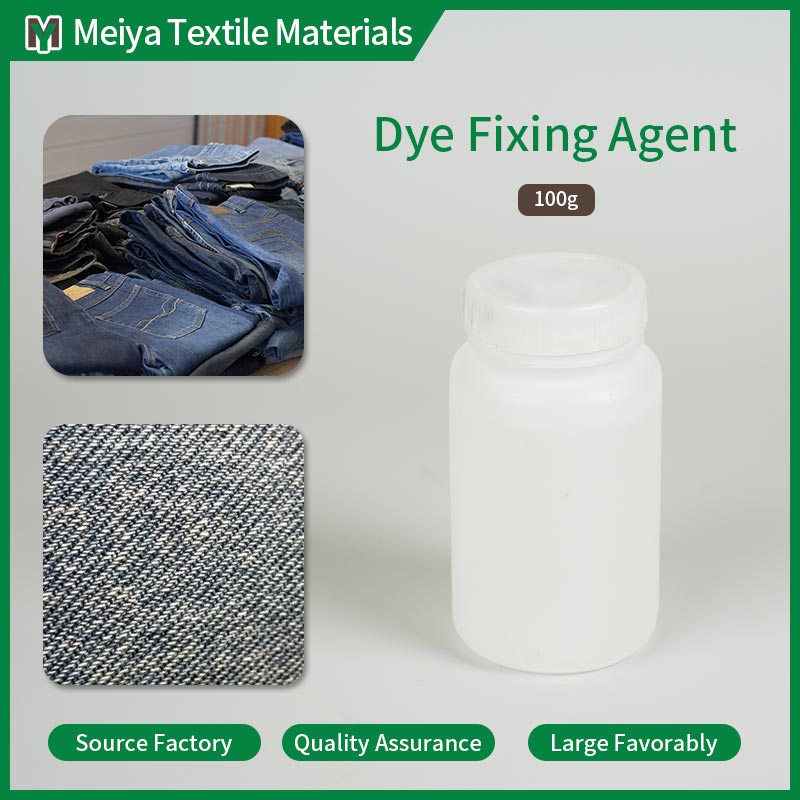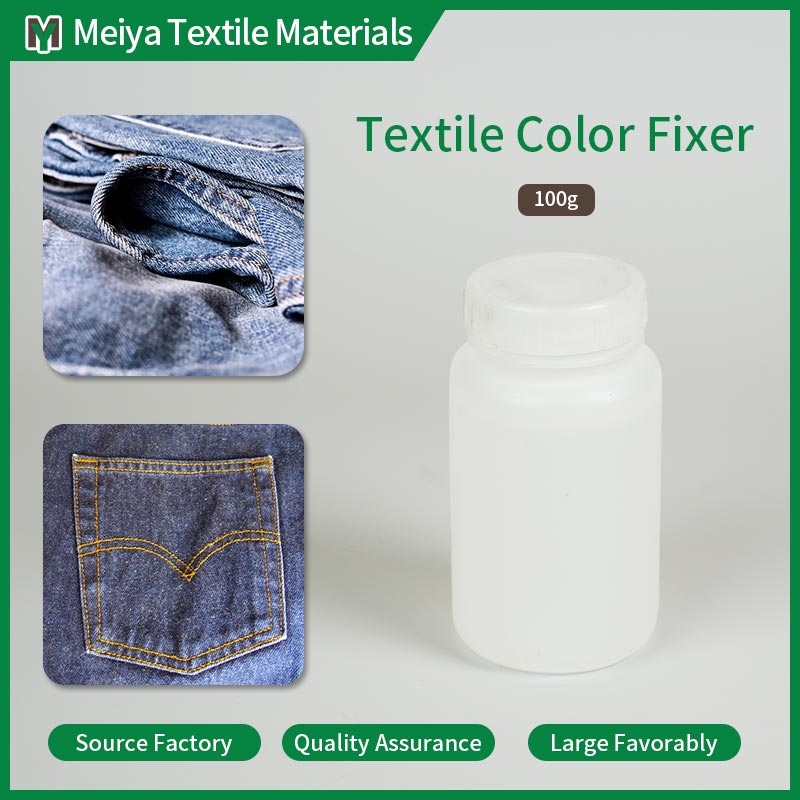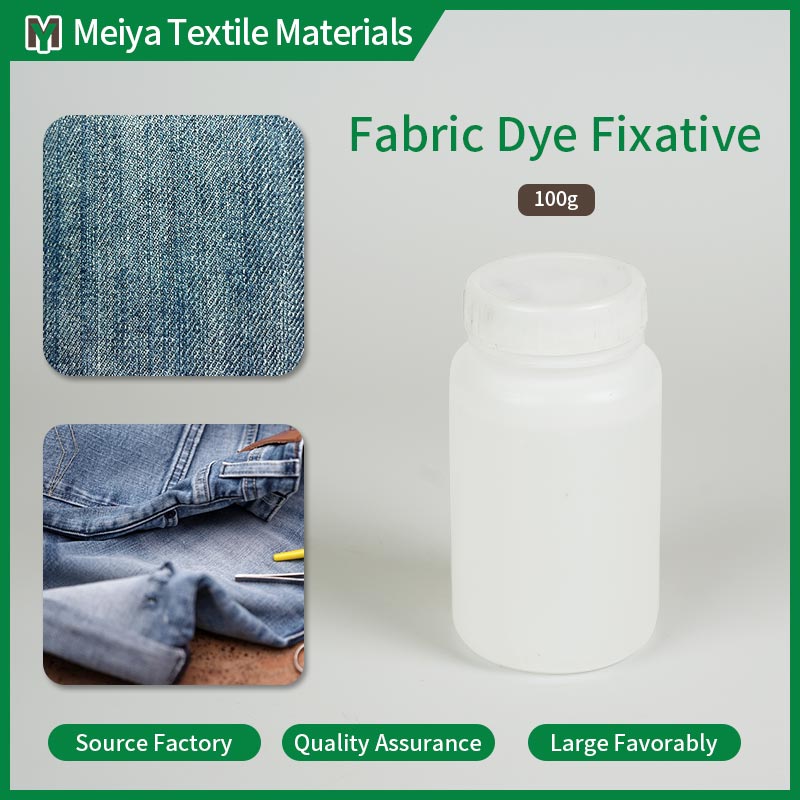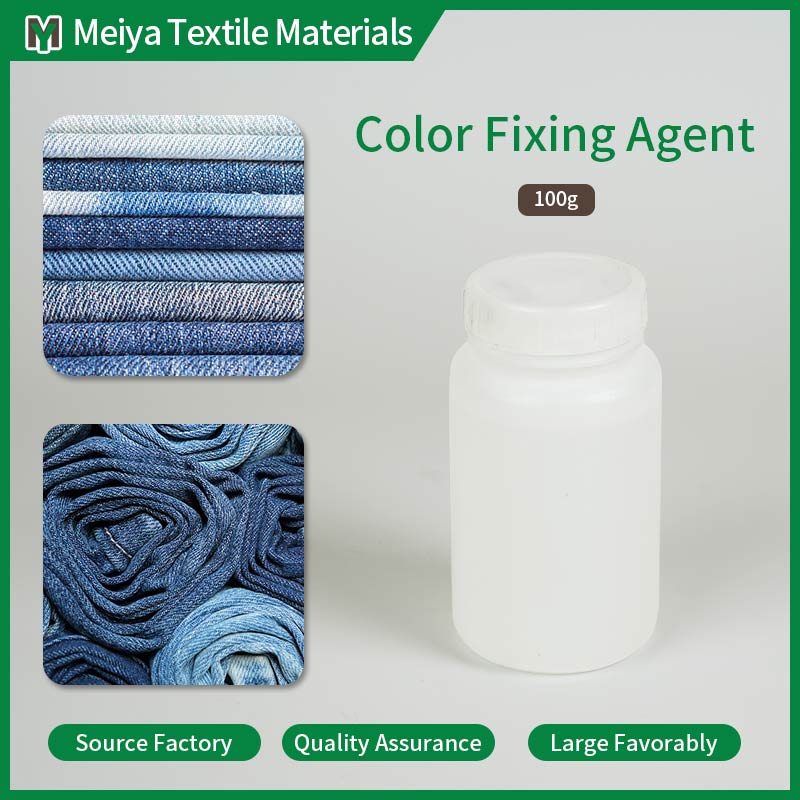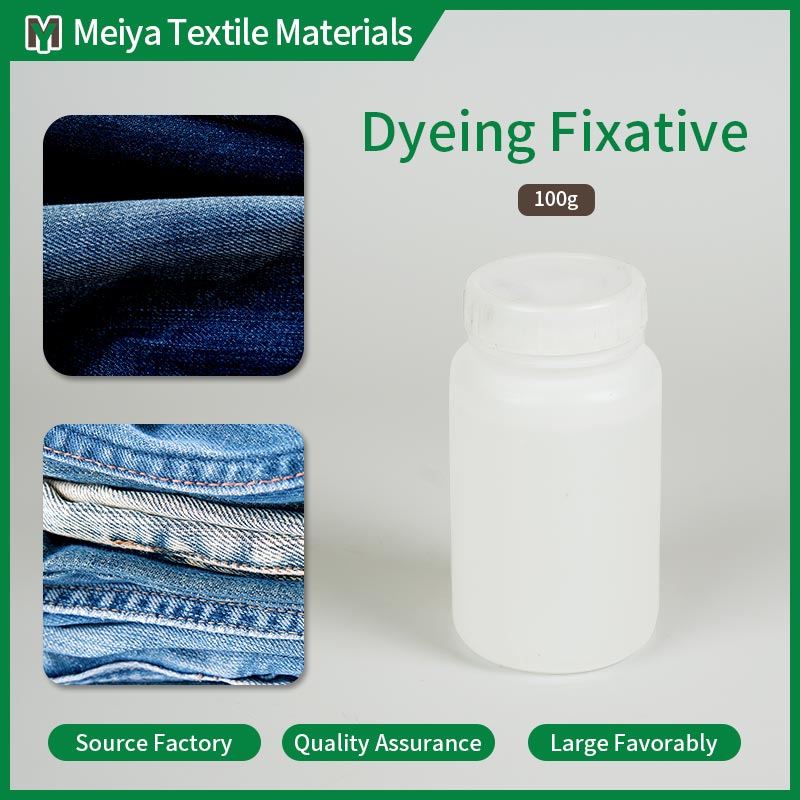Fabric Dye Fixing Agent
Please click the button below to contact us.
Introduction:Fabric Dye Fixing Agent is a chemical auxiliary agent specially used for post-dyeing treatment of textiles. It can form stable chemical bonds with dye molecules, thereby firmly fixing the dye on the fabric fibers.
Product Description
Fabric Dye Fixing Agent is a chemical auxiliary agent specially used for post-dyeing treatment of textiles. It can form stable chemical bonds with dye molecules, thereby firmly fixing the dye on the fabric fibers. This auxiliary agent is usually a high molecular polymer with multiple active groups that can undergo cross-linking reactions with dyes and fibers. Its main function is to improve the fastness of dyes on fabrics and prevent the dyes from falling off or fading under conditions such as washing, friction, and light. By applying a fixing agent to the dyed fabric, the color brightness and durability of the fabric can be significantly improved, while reducing the pollution of the dye to the environment.
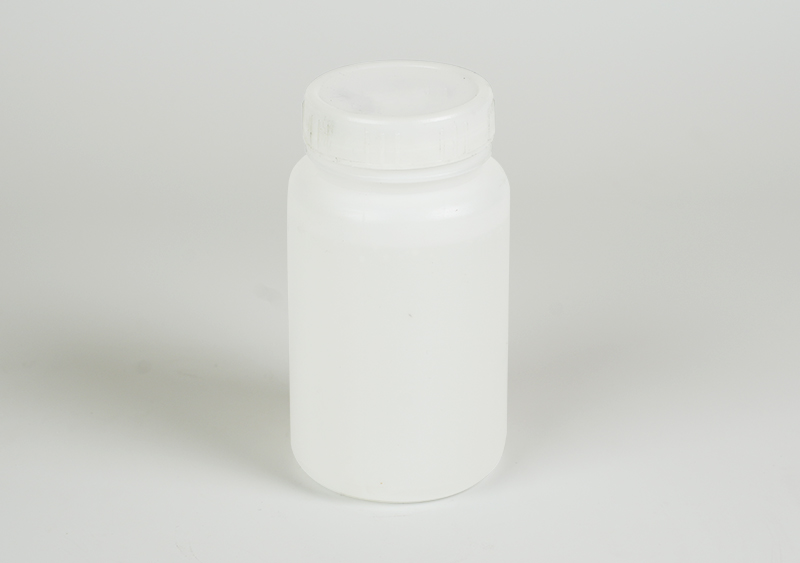
Fabric Dye Fixing Agent Features:
High molecular weight and strong adsorption: The molecular weight of Fabric Dye Fixing Agent is usually between 10,000 and 50,000 g/mol. This high molecular weight enables it to form a tight adsorption layer with dye molecules. For example, in the dye fixation treatment of cotton fabrics, the fixing agent molecules can evenly cover the surface of the dye particles to form a protective film with a thickness of about 0.1-0.3 μm. This protective film not only prevents the dissolution and diffusion of dye particles in water, but also enhances the binding force between the dye and the fiber, thereby significantly improving the dye's wash fastness, allowing the fabric to maintain bright colors after multiple washes.
Multifunctional active groups: Contains a variety of active groups, such as amino, hydroxyl and carboxyl groups. These groups can react chemically with different types of dyes (such as reactive dyes, direct dyes and vat dyes). For example, the amino group can form an ionic bond with the sulfonic acid group in the dye molecule; the carboxyl group can form an amide bond with the amino group in the dye. In the fixation experiment with cotton fabrics, the active groups of the fixing agent combined with the dye with an efficiency of up to 85% - 95%, ensuring the strong attachment of the dye to the fiber. This versatility enables it to be applied to various combinations of dyes and fibers to meet the fixation needs of different textiles.
Excellent washability: The washing fastness of the fabric treated with it can be improved by 3 - 5 levels (according to ISO 105-C06 standard). This means that under standard washing conditions, the fading degree of the fabric is significantly reduced. For example, after washing in a 40°C soap solution for 30 minutes, the fabric without the fixing agent may show obvious color fading and staining; while the fabric after using the fixing agent has almost the same color, and the staining degree is also improved from 3 - 4 levels to 5 levels. This washability not only extends the service life of the fabric, but also reduces the pollution of the dye to the environment during the washing process.
Good rubbing fastness: It can significantly improve the rubbing fastness of fabrics, making its dry rubbing fastness reach 4-5 levels, and wet rubbing fastness to 3-4 levels (according to ISO 105-X12 standard). In actual tests, untreated fabrics may show obvious white powdery fading after dry rubbing, and serious color transfer after wet rubbing; while the used fabrics only show slight color changes after dry rubbing, and the color transfer after wet rubbing is also significantly reduced. This performance improvement is particularly important for textiles that need to be rubbed frequently (such as jeans, sheets and sofa fabrics), which can ensure that the fabrics maintain color integrity in daily use.
Long-lasting light fastness: The light fastness of the treated fabrics under light conditions can be improved by 2-3 levels (according to ISO 105-B02 standard). In the simulated sunlight exposure experiment, fabrics without fixing agents may fade significantly after 50 hours of light exposure, and the color depth will decrease by about 30% - 40%; while the fabrics after using fixing agents will only reduce the color depth by about 5% - 10% even after 100 hours of light exposure. This improvement in light resistance allows the fabric to maintain its bright colors even when exposed to natural light or indoor light for a long time, which is particularly suitable for curtains, carpets and other decorative fabrics.
Environmentally friendly: It complies with many international environmental standards, such as REACH and OEKO-TEX. The degradability of its main ingredients in the natural environment is more than 80% (according to the OECD 301B test method). This means that during the wastewater treatment process, the residual part of the fixing agent can be decomposed into carbon dioxide and water by microorganisms in a relatively short time, and will not burden the sewage treatment system. At the same time, it does not contain any harmful substances such as heavy metals, formaldehyde and azo compounds, ensuring that the impact on the environment and human health during production, use and disposal is minimized.
Wide applicability: Suitable for a variety of fiber and dye combinations. For cotton fibers, the binding rate with reactive dyes can reach more than 90%; for polyester fibers, the binding rate with disperse dyes can also reach 85% - 90%. This means that whether it is natural or synthetic fibers, whether it is direct dyes, reactive dyes or disperse dyes, Fabric Dye Fixing Agent can play an excellent fixing effect. In the post-dyeing treatment of mixed fiber fabrics, it can simultaneously improve the fastness of dyes on different fibers, ensuring the uniformity and stability of the overall color of the fabric.
Good stability: Under normal storage conditions (temperature 15 - 30℃, relative humidity below 60%), its performance can be stably maintained for 12 - 24 months. During the validity period, the active ingredient reduction of the fixing agent does not exceed 5%, and the viscosity change range is controlled within ±10%. This stability ensures that users can use the product for a long time after purchase, reducing production interruptions and economic losses caused by product deterioration.
High efficiency with low addition amount: In the post-dyeing process, only 1% - 5% of the fabric weight is usually needed to achieve significant color fixation effect. For example, in the color fixation treatment of cotton fabrics, adding 2% of the color fixer can increase the wash fastness from level 2 - 3 to level 4 - 5. This low addition amount not only reduces production costs, but also reduces the impact on the environment, which meets the modern textile industry's requirements for efficient and environmentally friendly production.
Excellent compatibility: It has good compatibility with common textile auxiliaries (such as softeners, water-repellents and antistatic agents). In the post-dyeing process where multiple auxiliaries are used at the same time, precipitation, stratification or failure will not occur. For example, in the finishing process of cotton fabrics, when the color fixer and softener are mixed in a ratio of 1:1, the performance of both auxiliaries can be normally exerted, the softness and color fastness of the fabric are significantly improved, ensuring the smooth progress of the production process and the stability of product quality.
Fabric Dye Fixing Agent Application:
Post-dyeing treatment of cotton fabrics: Fabric Dye Fixing Agent is an indispensable auxiliary agent in the reactive dyeing process of cotton fabrics. In the soaping step after dyeing, 2% - 5% (relative to the weight of the fabric) of the fixing agent is added and treated at 40 - 50°C for 20 - 30 minutes. This treatment can effectively block the binding sites between the dye and the fiber, preventing the dye from hydrolyzing and falling off during subsequent washing and use. Compared with untreated cotton fabrics, its wash fastness is improved from level 2 - 3 to level 4 - 5, and the color brightness is improved by about 30% - 40%. This is essential for the production of high-quality cotton garments (such as T-shirts, shirts and bedding), which can ensure that the product can maintain good appearance and color after multiple washings.
Post-dyeing treatment of polyester fibers: Post-dyeing treatment of disperse dyes for polyester fibers can significantly improve the sublimation fastness and migration fastness of the dye. During the high temperature setting process, the fixing agent is added to the setting bath at a ratio of 1% - 3% and treated at 180 - 200℃ for 3 - 5 minutes. The sublimation fastness of the treated polyester fabric can be improved from 2 - 3 to 4 - 5, and the migration fastness can be improved from 3 to 4 - 5. In practical applications, for sportswear, curtains and automotive interiors made of polyester fibers, this performance improvement can prevent the sublimation and migration of dyes in high temperature environments, ensuring that the fabric maintains uniform color during long-term use.
Silk Fabric Dyeing Post-treatment: In the post-dyeing treatment of silk fabrics, Fabric Dye Fixing Agent can improve the binding fastness of dyes without damaging silk fibers. In the washing step after dyeing, add 1% - 2% of the fixing agent and treat at 30 - 35℃ for 10 - 15 minutes. The wet rubbing fastness of treated silk fabrics is improved from 2-3 to 3-4, and the washing fastness is improved from 3 to 4-5. For high-end silk products (such as silk scarves, pajamas and ties), this gentle but effective fixing treatment ensures that the fabric maintains its gorgeous color and soft feel during washing and use.
Wool fabric dyeing post-treatment: Applicable to the post-treatment of wool fabrics dyed with acid dyes. In the neutralization step after dyeing, add 3% - 5% of the fixing agent and treat at 40 - 45℃ for 20 - 30 minutes. This treatment not only improves the dye's soap fastness, but also prevents wool fibers from felting during washing. The soap fastness of treated wool fabrics is improved from 2-3 to 4-5, and the felting rate is reduced by about 50% - 70%. In the production of products such as sweaters, suit fabrics and carpets, this color fixing treatment ensures that wool fabrics maintain their excellent appearance and feel after multiple washes.
Post-dyeing treatment of mixed fiber fabrics: For mixed fiber fabrics such as cotton-polyester blends, Fabric Dye Fixing Agent can improve the fastness of dyes on different fibers at the same time. In the post-dyeing process, according to the composition ratio of the fibers, 2% - 4% of the color fixing agent is added and treated at 40 - 50℃ for 20 - 30 minutes. The treated cotton-polyester blended fabric has its wash fastness improved from 2-3 to 4-5, and the dry rubbing fastness improved from 3-4 to 4-5. This comprehensive color fixing effect is particularly suitable for the production of mixed fiber products such as work clothes, uniforms and home decoration fabrics, which can ensure the color stability and durability of the fabric in various use environments.
Post-dyeing treatment of functional textiles: When producing textiles with special functions (such as sun-protective clothing, waterproof fabrics and antibacterial fabrics), Fabric Dye Fixing Agent can improve the fastness of dyes without affecting their functionality. For example, in the production of sun-protective clothing, after adding 2% - 3% of the fixing agent and treating it at 40°C for 20 minutes, the ultraviolet protection factor (UPF) of the fabric is almost unaffected, while the washing fastness is improved from level 2 - 3 to level 4 - 5. This balance of performance allows functional textiles to meet consumers' color requirements while maintaining the integrity of their core functions.
Fabric Dye Fixing Agent Maintenance:
Storage environment control: Fabric Dye Fixing Agent should be stored in an environment with a temperature of 15 - 30℃ and a relative humidity of less than 60%. Excessive temperature will accelerate the change of its molecular structure, resulting in a reduction in active groups. For example, after being stored at 35℃ for 6 months, the active ingredients of the fixing agent may decrease by 10% - 15%. Excessive humidity will cause the fixing agent to absorb moisture and agglomerate, affecting its solubility and dispersibility during use. In winter, if the storage temperature is lower than 10℃, the viscosity of the fixing agent will increase and a gel-like substance may be formed. To ensure its stable performance, it is recommended to install temperature and humidity control equipment in the storage warehouse, and regularly monitor temperature and humidity changes to maintain the stability of the environment.
Container selection and sealing: Glass, stainless steel or high-density polyethylene (HDPE) containers should be used to store Fabric Dye Fixing Agent. These materials have good chemical stability and will not react with the fixing agent. The sealing of the container is very important, and a double-layer sealing structure is required. The first layer is a tight bottle cap or can cap, and the second layer can use sealing tape or sealing gasket. For example, for large-capacity storage tanks, flange connections can be used and sealed with fluororubber gaskets; for small bottle packaging, use a screw-on bottle cap with an inner liner. Check the sealing of the container regularly. If the sealing tape is found to be aging or the bottle cap is loose, it should be replaced or resealed in time. After each use, be sure to seal the cap immediately to prevent the color fixer from being exposed to the air for a long time to absorb moisture or volatilize.
Anti-pollution and impurity isolation: The storage warehouse should be kept clean to prevent the color fixer from contacting with dust, metal ions and other chemicals. Clean the warehouse floor regularly and lay dustproof cloth on the shelves. During the handling process, the operator should wear clean gloves to avoid bringing grease and dirt on the hands into the color fixer. If a small amount of impurities are mixed in the color fixer, it may cause precipitation during use or affect the binding effect with the dye. For example, after mixing with metal ions, it may react with the active groups in the color fixer to form an insoluble complex, reducing its color fixation performance. Therefore, before each use, the appearance of the fixing agent should be carefully checked to ensure that it is clear and free of impurities.
Reasonable planning of the order of use : The order of use of Fabric Dye Fixing Agent should be reasonably arranged according to the production plan, following the principle of "first in, first out". Since it has a certain shelf life (usually 1-2 years), long-term storage will lead to a gradual decline in performance. For example, when a batch of fixing agent is used 18 months after production, its fixing effect may be about 20%-30% lower than that of newly produced products. Establish detailed inventory management records, including information such as purchase date, batch, quantity and usage. Through reasonable inventory management, losses caused by expiration can be minimized and the fixing agent used each time can achieve optimal performance.
Regular inspection and quality monitoring : Conduct a preliminary inspection of the appearance and viscosity of Fabric Dye Fixing Agent every month. Under normal circumstances, the fixing agent should be a clear and transparent or light yellow liquid with a viscosity range of 500-1,500 mPa・s (at 25℃). If the fixing agent is found to be turbid, stratified, or has abnormal changes in viscosity, it may be due to improper storage conditions or deterioration. Detailed performance testing is carried out once a quarter, including indicators such as the content of active groups and the effect of improving water fastness to washing. The fixing agent can be compared with the standard sample to evaluate whether its performance meets the requirements. At the same time, a quality monitoring file should be established to record the results of each inspection so as to timely discover the quality change trend and take corresponding measures, such as adjusting storage conditions or replacing products.
Safety protection and emergency treatment: Although Fabric Dye Fixing Agent is generally of low toxicity, safety protection should still be taken during storage and use. Operators should wear goggles, masks and protective gloves when handling and using to prevent the fixing agent from contacting the skin and eyes. If it accidentally contacts the skin, it should be rinsed immediately with plenty of clean water and washed with mild soap; if it splashes into the eyes, rinse with running water for at least 15 minutes and seek medical attention in time. The storage warehouse should be equipped with fire extinguishers (such as dry powder fire extinguishers or carbon dioxide fire extinguishers) in case of fire. Develop an emergency response plan. If a fixing agent leaks, people should be evacuated immediately, and sand or special adsorbent materials should be used for containment and adsorption. Then the contaminated materials should be properly handled to avoid pollution to the environment.
Fabric Dye Fixing Agent FAQs:
1. What is a Fabric Dye Fixing Agent and what is its mode of action?
A Fabric Dye Fixing Agent is a chemical substance that is applied during textile dyeing procedures to prevent the subsequent loss to the product of the color. It functions by increasing the forces that exist between the dye particles and the fibres, holding the dye onto the fabrics more securely. This retards color changes, color bleeding, and color washes out even after a long time. Our reactive Fabric Dye Fixing Agent is specially designed to be suitable with different types of dyes, thus giving the fabrics wider applications with rich colors that do not easily fade away.
2. Is it able to be applied to any type of textiles?
Yes, the Fabric Dye Fixing Agents are compatible with an extensive range of textile fibres such as natural fibres like cotton and wool, as well as man-made fibres like polyester and nylon. Using reactive, acid and disperse dyes, the agent can be used on various textile types with expected effects.
3. How is the Fabric Dye Fixing Agent applied in the course of the dyeing process?
In most cases, the application of the fixative precedes the rinsing stage of the dyeing process. A solution of the microscopic fixative is applied to the fabric in waves and the overlapping parts are in the same direction. This is followed by the drying of the fabric after application and washing of the fabric to take away excessive application. Step by step instructions on implementation are attached to every batch to maintain uniformity and achieve the best results.
4. In what ways does your Fabric Dye Fixing Agent compare to its fellow competitors?
What sets our Fabric Dye Fixing Agent apart from other coatings is its effectiveness, ease of use, and good compatibility with a wide range of dyes and textile fibers. It offers better color fastness than most alternatives, complemented by durability in fabric and fade and bleeding color protection features. Committed to customer satisfaction, we are also a reputable fabric additive supplier with the complete assurance of quality and effectiveness.
5. Is your Fabric Dye Fixing Agent a hazard to the workers or the ecosystem of the world?
Definitely, we prioritize safety above everything else. Our Fabric Dye Fixing Agent has been manufactured in compliance with stringent safety and environmental standards. It is also the case that our Fabric Dye Fixing Agent is not hazardous to individuals who use it responsibly and according to the directions provided. Moreover, in every aspects of our business, we encourage our clients to use our products in a green manufacturing process by constantly seeking ways to reduce the environmental footprints of our products.

